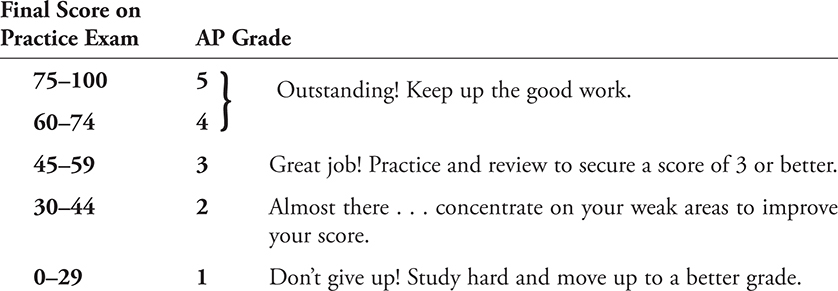5 Steps to a 5: AP Physics 2: Algebra-Based 2024 - Jacobs Greg 2023
STEP 5 Build Your Test-Taking Confidence
The AP Physics 2 Practice Exams 1
Taking the Practice Exams
Taking a full-length practice test is one of the most important things you can do to prepare yourself for the AP Physics 2 exam. Besides helping build your test-taking confidence, you’ll be able to practice pacing yourself to make the most efficient use of your limited time. Of course, it will also help to familiarize yourself with the test so that there are no surprises on test day. Finally, taking the practice exam provides a good review of the physics content on which you will be tested; in fact, you may find a topic or two about which you’ll want to go back and reread a section of this book. In the pages that follow, you’ll find two practice exams, each followed by complete explanations for all questions. Be sure to take both tests.
Structure of the Exam
Remember the structure of the test described in Chapter 2? To refresh your memory, you may want to take another look at this chart. The practice exams in this book follow exactly the structure and timing of the real test. Remember that you may use a calculator, the equation sheet, and the table of information. The equations and information table can be found in the appendix. However, I recommend that you download and use the most current one from the College Board at: https://apstudents.collegeboard.org/courses/ap-physics-2-algebra-based/assessment.
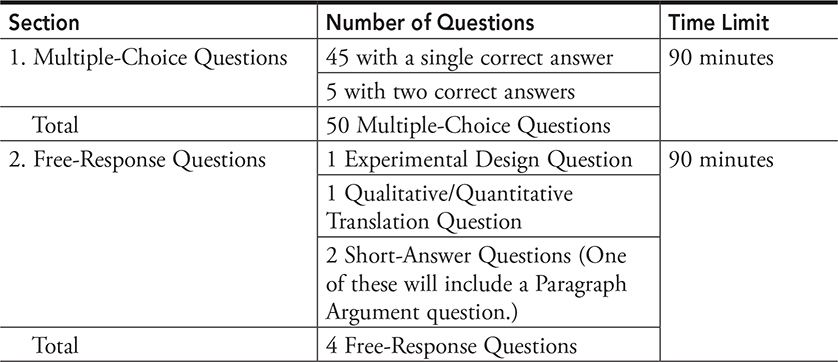
Tips for Taking the Practice Exams
When taking a practice test, try to replicate, as much as possible, the actual test-taking experience. Here are some tips to make the most of the practice exams:
• Set aside a block of time to take each part of the test. There should be no distractions or interruptions. Make sure your cell phone won’t disturb your concentration.
• Carefully time yourself—90 minutes for the multiple-choice section and 90 minutes for the free-response section. Check the time occasionally to practice pacing yourself, but don’t become overly obsessive watching the clock!
• Tear out the answer sheet provided and mark your answers in pencil on the grid, just like on the actual test.
• Check your answers against the solutions provided to see how well you did. You can do this after you finish each 90-minute section. Don’t just read the explanations for the questions you missed, be sure you also look at the explanations for the ones you got right, especially those you weren’t sure of. Even when you got a question right, you need to understand why the answer you selected is correct and why the other answer choices are wrong.
Test-Taking Strategies
Remember the strategies you learned in Chapters 6—8? These will help you use the limited testing time more efficiently, allowing you to get the best score you can. Here are brief summaries of the most important strategies for taking the AP Physics 2 exam.
Strategies for the Multiple-Choice Section
• Work all the easy questions first and leave the harder ones for later.
• Answer every question. You won’t lose points for guessing.
• Read the stem of the question and look at the answer choices before you jump into trying to answer the question.
• Cross out answer choices that you know can’t be correct. Choose the best answer from what is left.
• Don’t be afraid of the multiple-correct questions, which are the last five questions.
• Keep calm and determined. Nobody gets all the multiple-choice questions correct. Not even AP Physics 2 teachers! You are shooting for 40%—45% for a 3 and 75% for a 5.
Strategies for the Free-Response Section
• Skim all the questions and start with the one that looks the easiest and work your way to the hardest one.
• Don’t leave any part on any question blank. You are trying to earn partial credit. You can’t earn points when you leave it blank.
• Show all your work. Show the steps you are taking to come to a solution. Go for partial credit.
• Don’t try to snow the exam reader with a bunch of malarkey. It will only lower your score. Show your knowledge of physics.
• The AP Physics readers consistently tell us that students need to be more precise in their explanations. Remember, you are not writing poetry that is up to the interpretation of the reader. You need to use “physics language” and avoid the use of pronouns. Instead of saying “It gets pushed away.” Be more precise! Say something more like this: “The electron receives a force to the right due to the electric field.” Or, “The electric force pushes the electron to the right.” Speak in “Physics” and your grade will improve.
• Keep your written answers short and to the point. Remember to be CLEVeR! Make your CLaim. Give your EVidence. Explain your Reasoning and move on.
• For heaven’s sake, write clear, orderly, and legibly! What can’t be read gets a zero.
• Keep calm and determined. Nobody earns all of the points. Not even AP Physics 2 teachers! You are shooting for 40%—45% for a 3 and 75% for a 5.
AP Physics 2: Practice Exam 1
Multiple-Choice Questions
ANSWER SHEET
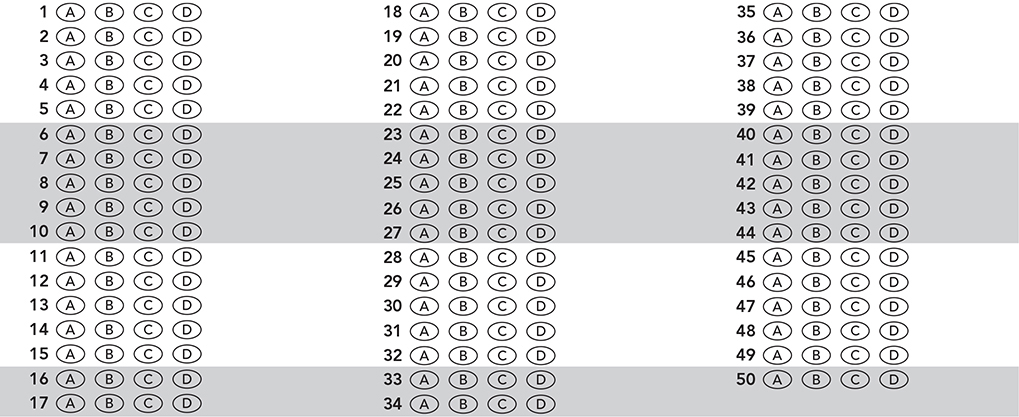
AP Physics 2: Practice Exam 1
Section 1 (Multiple Choice)
Directions: The multiple-choice section consists of 50 questions to be answered in 90 minutes. You may write scratch work in the test booklet itself, but only the answers on the answer sheet will be scored. You may use a calculator, the equation sheet, and the table of information. These can be found in the appendix or you can download the official ones from the College Board at: https://apstudents.collegeboard.org/courses/ap-physics-2-algebra-based/assessment.
Questions 1—45: Single-Choice Items
Choose the single best answer from the choices provided, and mark the answer with a pencil on the answer sheet.
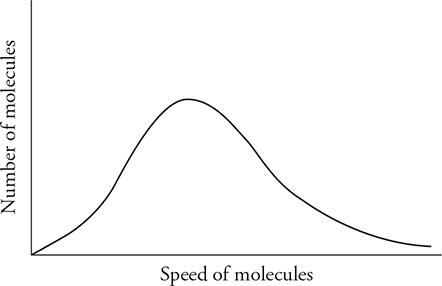
1. The graph shows the distribution of speeds for one mole of hydrogen at temperature T, pressure P, and volume V. How would the graph change if the sample was changed from one mole hydrogen to one mole of argon at the same temperature, pressure, and volume?
(A) The peak will shift to the left.
(B) The peak will shift upward and to the left.
(C) The peak will shift to the right.
(D) The peak will shift downward and to the right.
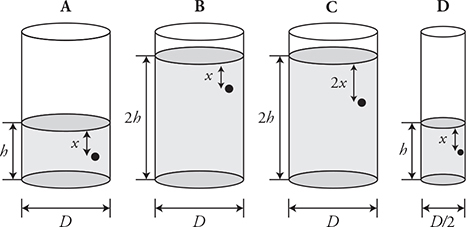
2. The figure shows four cylinders of various diameters filled to different heights with water. A hole in the side of each cylinder is plugged by a cork. All cylinders are open at the top. The corks are removed. Which of the following is the correct ranking of the velocity of the water (v) as it exits each cylinder?
(A) vA > vD > vC > vB
(B) vA = vD > vC > vB
(C) vB > vC > vA = vD
(D) vC > vA = vB = vD
3. An observer can hear sound from around a corner but cannot see light from around the same corner. Which of the following helps to explain this phenomenon?
(A) Sound is a longitudinal wave, and light is an electromagnetic wave.
(B) Sound is a mechanical wave, and light is a transverse wave.
(C) Light travels at a speed much faster than that of sound.
(D) Light has a much smaller wavelength than sound.
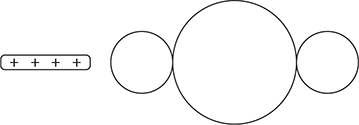
4. A positively charged rod is brought near to but not touching three metal spheres that are in contact with each other, as shown in the figure. Which is the best representation of the charge arrangement inside the three spheres?
(A) 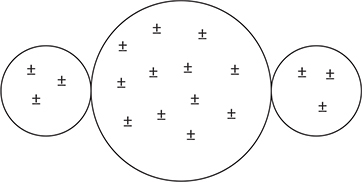
(B) 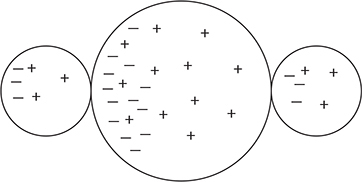
(C) 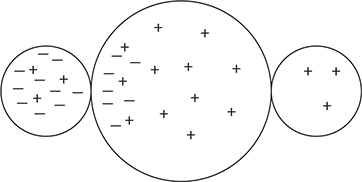
(D) 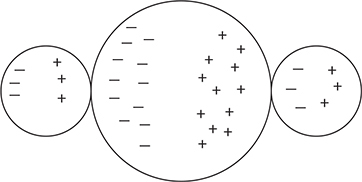
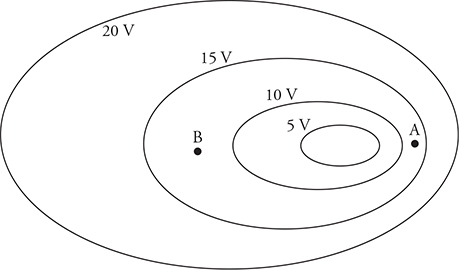
5. Isolines of equal electric potential in a region of space are shown in the figure. Points A and B are in the plane of the isolines. Which of the following correctly describes the relationship between the magnitudes and directions of the electric fields at points A and B?
(A) EA = EB and is in the same direction.
(B) EA ≠ EB and is in the same direction.
(C) EA = EB and is in the opposite direction.
(D) EA ≠ EB and is in the opposite direction.
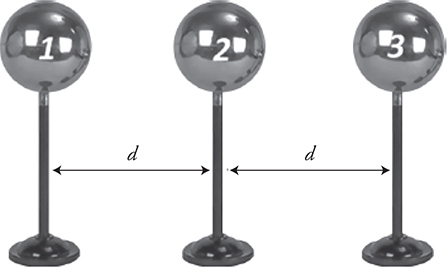
6. The metal spheres on insulating stands 1, 2, and 3 are all identical and situated as shown in the figure. Spheres 1 and 2 have a charge of —Q, and sphere 3 has a charge of +2Q. The force of sphere 1 on sphere 2 is +F. What is the magnitude of the net force on sphere 3 in terms of F?
(A) 3/2 F
(B) 2 F
(C) 5/2 F
(D) 3 F

7. Three cylindrical resistors made of the same material but different dimensions are connected, as shown in the figure. A battery is connected to produce current through the resistors. Which is the correct ranking of the potential differences across the individual resistors?
(A) VA = VB = VC
(B) VA > VB > VC
(C) VA = VB > VC
(D) VC > VB > VA
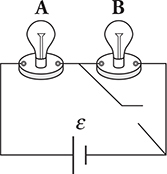
8. The figure shows two bulbs connected to a battery in a circuit with a switch that is originally in the closed position. What happens to the brightness of the bulbs when the switch is opened?

9. An astronaut in a rocket is passing by a space station at a velocity of 0.33 c. Looking out the window, the astronaut sees a scientist on the space station fire a laser at a target. The laser is pointed in the same direction that the astronaut is traveling. On which of the following observations will the astronaut and scientist agree?
(A) The length of the rocket
(B) The time it takes the laser to hit the target
(C) The speed of the laser beam
(D) The astronaut and scientist will not agree on any of these measurements.
10. A proton is moving toward the top of the page when it encounters a magnetic field that changes its direction of motion. After encountering the magnetic field, the proton’s velocity vector is pointing out of the page. What is the direction of the magnetic field? Assume gravitational effects are negligible.
(A) Toward the bottom of the page
(B) To the right
(C) To the left
(D) Into the page
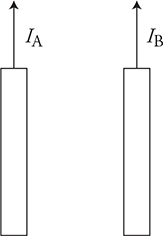
11. Two long parallel wires carry currents (IA and IB), as shown in the figure. Current IA in the left wire is twice that of current IB in the right wire. The magnetic force on the right wire is F. What is the magnetic force on the left wire in terms of F?
(A) F in the same direction
(B) F in the opposite direction
(C) F/2 in the same direction
(D) F/2 in the opposite direction
Questions 12 and 13
Four identical resistors of resistance R are connected to a battery, as shown in the figure. Ammeters A1 and A2 measure currents of 1.2 A and 0.4 A, respectively.
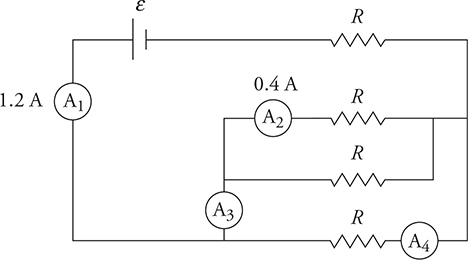
12. What are the currents measured by ammeters A3 and A4?
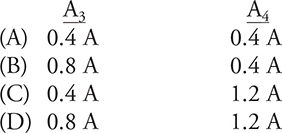
13. What is the equivalent resistance of the circuit?
(A) ¼ R
(B) 4/3 R
(C) 5/2 R
(D) 4 R
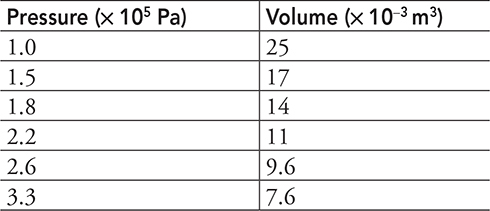
14. In an experiment, a gas is confined in a cylinder with a movable piston. Force is applied to the piston to increase the pressure and change the volume of the gas. Each time the gas is compressed, it is allowed to return to a room temperature of 20°C. The data gathered from the experiment is shown in the table. What should be plotted on the vertical and horizontal axes so the slope of the graph can be used to determine the number of moles of gas in the cylinder?
(A) P and V2
(B) P and V
(C) P and (V)½
(D) P and 1/V
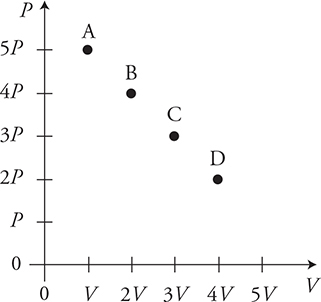
15. The figure shows the pressure and volume of a gas at four different states. Which of the following correctly ranks the temperature of the gas at the different states?
(A) TA > TB > TC > TD
(B) TB = TC > TA = TD
(C) TC > TB = TD > TA
(D) TD > TC > TB > TA

16. The figure shows the pressure and volume of three moles of gas being taken through two different processes. Which of the following is correct concerning the two processes shown in the figure?
(A) ΔU1 = ΔU2 and W1 = W2
(B) ΔU1 = ΔU2 and W1 > W2
(C) ΔU1 > ΔU2 and W1 = W2
(D) ΔU1 > ΔU2 and W1 > W2
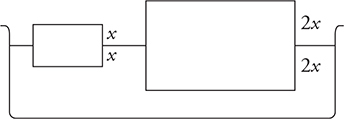
17. Two blocks of different sizes and masses float in a tray of water. Each block is half submerged, as shown in the figure. Water has a density of 1,000 kg/m3. What can be concluded about the densities of the two blocks?
(A) The two blocks have different densities, both of which are less than 1,000 kg/m3.
(B) The two blocks have the same density of 500 kg/m3.
(C) The two blocks have the same density, but the density cannot be determined with the information given.
(D) The larger block has a greater density than the smaller block, but the densities of the blocks cannot be determined with the information given.
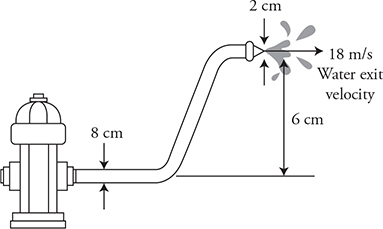
18. Firefighters use a hose with a 2 cm diameter exit nozzle connected to a hydrant with an 8 cm diameter opening to attack a fire on the second floor of a building 6 m above the hydrant, as shown in the figure. What pressure must be supplied at the hydrant to produce an exit velocity of 18 m/s? (Assume the density of water is 1,000 kg/m3, and the exit pressure is 1 × 105 Pa.)
(A) 1.7 × 105 Pa
(B) 2.0 × 105 Pa
(C) 2.6 × 105 Pa
(D) 3.2 × 105 Pa
19. Two electrons exert an electrostatic repulsive force on each other. Is it possible to arrange the two electrons so the gravitational attraction between them is large enough to cancel out the electric repulsive force?
(A) No, the charge of the electrons squared is much larger than the mass of the electrons squared.
(B) No, there is no gravitational force between subatomic particles.
(C) Yes, reducing the radius between the electrons will increase the gravitational force as it is proportional to the inverse of the radius squared.
(D) Yes, increasing the distance between the electrons will reduce the electrostatic repulsion until it is equal to the gravitational force.
20. The news reports the discovery of two new particles by the research facility CERN in Geneva. The first particle, dubbed Alithísium, is large with a mass equivalence of 125 GeV/c2 ± 15 GeV/c2 and a net charge of —1.55 × 10—18 C ± 0.1 × 10—18. The second particle, Psevdísium, has a mass of 5.4 × 10—4 u ± 0.1 × 10—4 u and a charge of 1.6 × 10—20 C ± 0.5 × 10—20. Which of the following is most correct concerning the two new particles?
(A) Both particles appear reasonable.
(B) Alithísium appears reasonable, but Psevdísium does not.
(C) Psevdísium appears reasonable, but Alithísium does not.
(D) Neither particle appears reasonable.
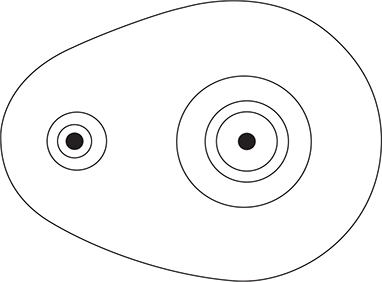
21. The figure shows isolines of constant electric potential surrounding two charges. Which of the following correctly describes the two charges?
(A) The charges are the same magnitude and the same sign.
(B) The charges are the same magnitude but different signs.
(C) The charges are different magnitudes but the same sign.
(D) The charges are different magnitudes and different signs.
22. An iron magnet is broken in half at the midpoint between its north and south ends. What is the result?
(A) A separate north pole and south pole, each with the same magnetic strength as the original magnet
(B) A separate north pole and south pole, each with half the magnetic strength of the original magnet
(C) Two separate north-south magnets, each with the same magnetic strength as the original magnet
(D) Two separate north-south magnets, each with half the magnetic strength of the original magnet
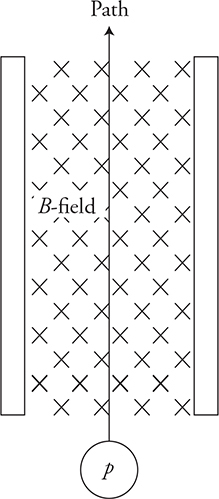
23. A magnetic field, directed into the page, is placed between two charged capacitor plates, as shown in the figure. The magnetic and electric fields are adjusted so a proton moving at a velocity of v will pass straight through the fields. The speed of the proton is doubled to 2v. Which of the following force diagrams most accurately depicts all the forces acting on the proton when traveling at 2v?
(A) ![]()
(B) ![]()
(C) ![]()
(D) 
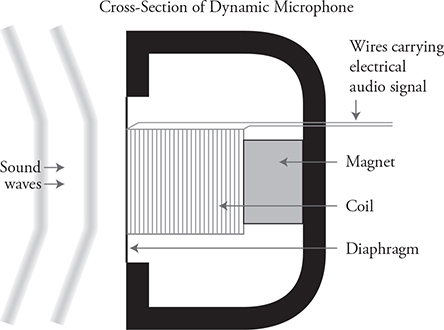
24. A dynamic microphone contains a magnet and a coil of wire connected to a movable diaphragm, as shown in the figure. Sound waves directed at the diaphragm generate a current in the wires leading from the coil. Which of the following helps to explain why this occurs?
(A) The area of the coil changes.
(B) The magnitude of the magnetic field produced by the magnet changes.
(C) The angle between the plane of the coil and the magnetic field produced by the magnet change.
(D) The strength of the magnetic field in the plane of the coil changes.
25. A lens and a mirror both have a focal length of f in air. Both are submerged in water, and the focal length fwater is measured for both. How does the focal length under water compare to the focal length in air?

26. Which of the following correctly describes the motion of the electric and magnetic fields of a microwave transmitted by a cell phone?
(A) Both the electric and magnetic fields oscillate in the same plane and perpendicular to the direction of wave propagation.
(B) Both the electric and magnetic fields oscillate perpendicular to each other and to the direction of wave propagation.
(C) The electric field oscillates perpendicular to the direction of wave propagation. The magnetic field oscillates parallel to the direction of wave propagation.
(D) Both the electric and magnetic fields oscillate parallel to the direction of wave propagation.

27. An optics bench is set up on a meter stick, as shown in the figure. The light source is a candle placed at x0. The lens is located at x1. The screen is moved until a sharp image appears at location x2. The lens and screen are moved multiple times to produce crisp images of differing sizes. The data for each x0, x1, and x2 location is recorded in a table. Which of the following procedures will allow a student to determine the focal length of the lens?
(A) Plot x2 as a function of x0. The focal length will be the vertical axis intercept.
(B) Plot (x2 — x1) as a function of (x0 — x1). The focal length will be the vertical axis intercept.
(C) Plot 1/x2 as a function of 1/x0. The focal length will be the inverse of the vertical axis intercept.
(D) Plot 1/(x2 — x1) as a function of 1/(x0 — x1). The focal length will be the inverse of the vertical axis intercept.
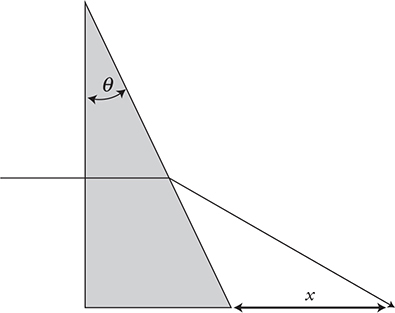
28. A laser beam passes through a prism and produces a bright dot of light a distance of x from the prism, as shown in the figure. Which of the following correctly explains the change in distance x as the angle (θ) of the prism is decreased?
(A) The distance x increases because the angle on incidence increases.
(B) The distance x increases because the angle of incidence decreases.
(C) The distance x decreases because the angle on incidence increases.
(D) The distance x decreases because the angle of incidence decreases.
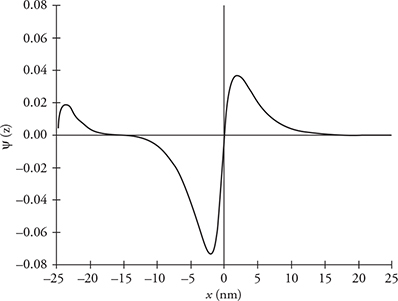
29. The graph shows the wave function of a particle as a function of x in the region between —25 nm < x < +25 nm. At which of the following positions is the probability of finding the particle greatest?
(A) —24 nm
(B) —15 nm and 0.0 nm
(C) —2 nm
(D) 2 nm
30. A nucleus of ![]() goes through a sequence of decays during which it emits four beta particles and some alpha particles to finally end up as a stable
goes through a sequence of decays during which it emits four beta particles and some alpha particles to finally end up as a stable ![]() nucleus. How many alpha particles have been emitted in this process?
nucleus. How many alpha particles have been emitted in this process?
(A) 32
(B) 26
(C) 8
(D) 4
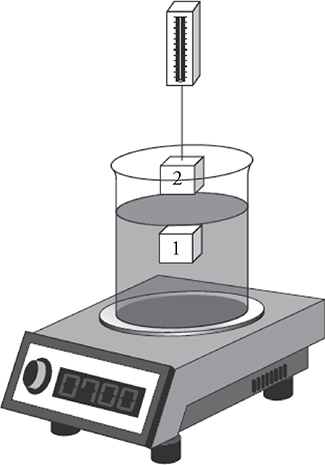
31. A beaker of water sits on a balance. A metal block with a mass of 190 g is held suspended in the water by a spring scale in position 1, as shown in the figure. In this position, the reading on the balance is 1,260 g, and the spring scale reads 120 g. When the block is lifted from the water to position 2, what are the readings on the balance and spring scale?

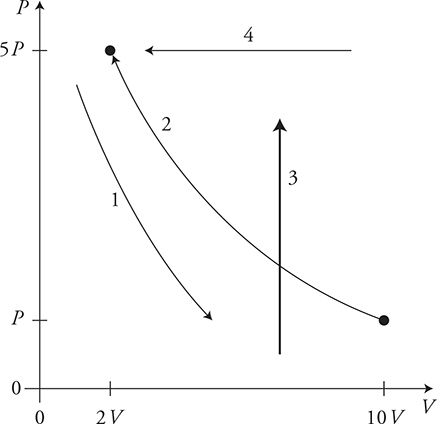
32. The figure shows four samples of gas being taken through four different processes. Process 1 is adiabatic. In which process is heat being transferred to the gas sample from the environment?
(A) 1
(B) 2
(C) 3
(D) 4
33. Two sealed cylinders holding different gases are placed one on top of the other so heat can flow between them. Cylinder A is filled with hydrogen. Cylinder B is filled with helium moving with an average speed that is half that of the hydrogen atoms. Helium atoms have four times the mass of hydrogen atoms. Which of the following best describes the transfer of heat between the two containers by conduction?
(A) Net heat flows from cylinder A to cylinder B, because heat flows from higher kinetic energy atoms to lower kinetic energy atoms.
(B) Net heat flows from cylinder B to cylinder A, because heat flows from higher kinetic energy atoms to lower kinetic energy atoms.
(C) There is no net heat transfer between the two cylinders, because both gases have the same average atomic kinetic energy.
(D) There is no net heat transfer between the two cylinders, because heat conduction requires the movement of atoms between the cylinder, but the cylinders are sealed.
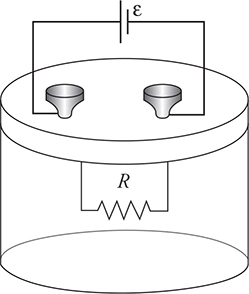
34. A resistor of resistance (R) is sealed in a closed container with n moles of gas inside. A battery of emf (ε) is connected to the resistor. Which of the following graphs shows the correct relationship between the gas atoms’ average velocity (vavg) and electrical energy (E) supplied to the resistor?
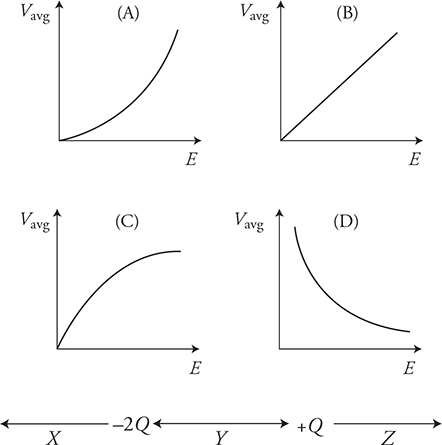
35. Two charges (—2Q and +Q) are located as shown in the figure. Three regions are designated in the figure: X is to the left of —2Q; Y is between the two charges; and Z is to the right of +Q. Which of the following correctly ranks the magnitude of electric field in the three regions?
(A) EX > EY > EZ
(B) EY > EX > EZ
(C) EY > EX = EZ
(D) It is not possible to rank the magnitudes of the electric fields without more information.
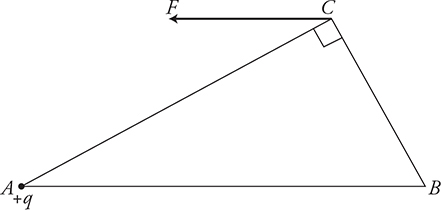
36. A positive charge (+q) is placed at vertex A of a triangle, as shown in the diagram. What charge must be placed at vertex B to cause an electron placed at vertex C to receive a force as shown?
(A) Positive and smaller than |+q|
(B) Positive and larger than |+q|
(C) Negative and smaller than |+q|
(D) Negative and larger than |+q|
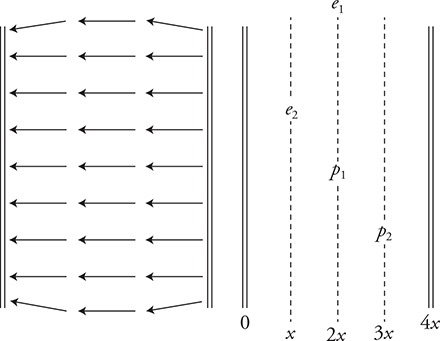
37. The left figure shows a capacitor with a horizontal electric field. The distance between the plates is 4x. The right figure shows two electrons, e1 and e2, and two protons, p1 and p2, which are placed between the plates at the locations shown. Which of the following is a correct statement about the forces on the charges?
(A) The forces on e1 and e2 are not the same in magnitude but are the same in direction.
(B) All four particles receive the same magnitude of force but not all in the same direction.
(C) The force on p1 is the largest in magnitude because it is in the middle of the capacitor where the electric field is strongest.
(D) The forces on e2 and p2 are the largest in magnitude because they are closer to the charged plates.

38. The circuit shown in the figure has two resistors, an uncharged capacitor, a battery, two ammeters, and a switch initially in the open position. What will happen to the current measured in the ammeters from the instant the switch is closed to a long time after the switch is closed?
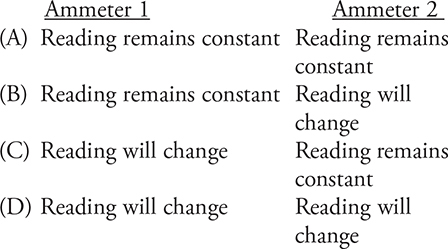
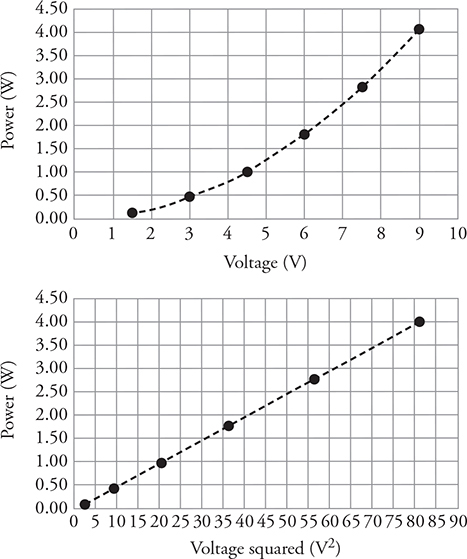
39. A single resistor is connected to a voltage source that consists of batteries with the same voltage connected in series. The power dissipated by the resistor for various voltages is shown in the two graphs. What is the resistance of the resistor?
(A) 0.05 Ω
(B) 0.22 Ω
(C) 4.5 Ω
(D) 20 Ω
40. Compasses are arranged in a tight circle around a long wire that is perpendicular to the plane of the compasses. The wire is represented in the figures by a dot. The wire carries a large current directly into the page. Which of the following best depicts the orientation of the compass needles?
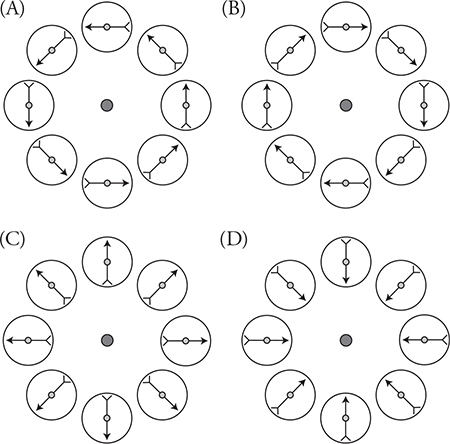
41. A mirror produces an upright image one-half the height of the object when the object is 12 cm from the mirror’s surface. What is the focal length of the mirror?
(A) —12 cm
(B) —4 cm
(C) 4 cm
(D) 6 cm
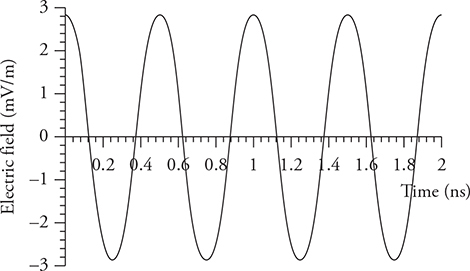
42. Which of the following best represents the electric field (E) measured in mV/m as a function of time measured in nanoseconds (ns)?
(A) E = 6cos(25.1t)
(B) E = 6cos(12.6t)
(C) E = 3cos(12.6t)
(D) E = 3cos(25.1t)
43. A light ray with a wavelength of λw and a frequency of fw in water (n = 1.33) is incident on glass (n = 1.61). In the glass, the wavelength and frequency of the light is λg and fg. How do the values of wavelength and frequency of the ray of light in water compare to those in glass?

44. Which of the following explains why the nucleus of a stable atom is bound together?
(A) The gravitational force between the neutrons and protons is greater than the repulsive electric force between the protons.
(B) The neutrons polarize and create an attractive electric force that cancels the repulsive electrostatic force of the protons.
(C) The orbit of electrons creates a magnetic force on the protons that is greater than the repulsive electric force.
(D) The strong force between nucleons is greater than the repulsive electric force of the protons.
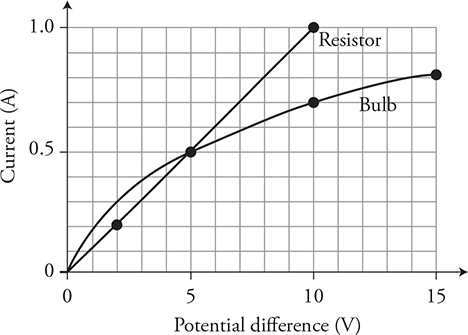
45. The figure shows current as a function of electric potential difference for a resistor and bulb. Are the devices ohmic?
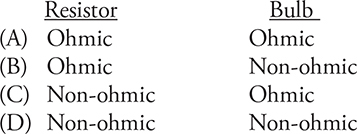
Questions 46—50: Multiple-Correct Items
Directions: Identify exactly two of the four answer choices as correct, and mark the answers with a pencil on the answer sheet. No partial credit is awarded; both of the correct choices, and none of the incorrect choices, must be marked to receive credit.
46. Four identical capacitors with a plate area of A, a distance between the plates of d, and a dielectric constant k are connected to a battery, a resistor, and a switch in series. The switch is closed for a long time. The total energy stored in the set of four capacitors is U. The four capacitors in series are to be replaced with a single capacitor that will store the same energy as the four-capacitor set. Which capacitor geometry will accomplish this? (Select two answers.)
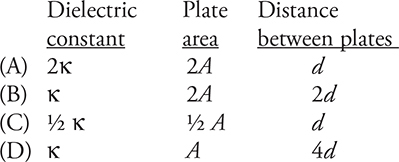
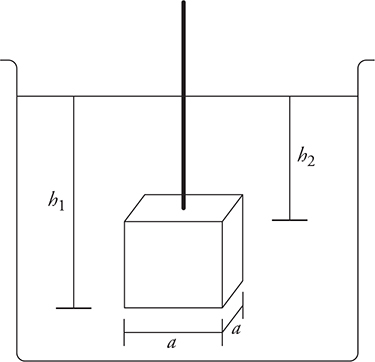
47. A mass (m) is suspended in a fluid of density (ρ) by a thin string, as shown in the figure. The tension in the string is T. Which of the following is an appropriate equation for the buoyancy force? (Select two answers.)
(A) Fb = mg
(B) Fb = mg — T
(C) Fb = a2 ρgh1
(D) Fb = a2 ρg(h1 — h2)
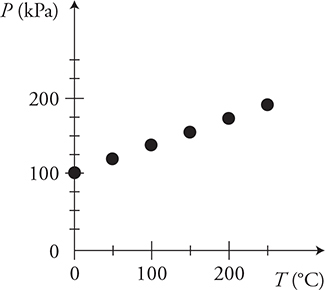
48. In an experiment, a sealed container with a volume of 100 ml is filled with hydrogen gas. The container is heated to a variety of temperatures, and the pressure is measured. The data from the experiment is plotted in the figure. Which of the following methods can be used to determine additional information regarding the gas? (Select two answers.)
(A) The slope can be used to calculate the number of atoms in the gas.
(B) The area under the graph can be used to calculate the work done on the gas.
(C) The vertical axis can be used to calculate the force the gas exerts on the container.
(D) The x-intercept can be used to estimate the value of absolute zero.

49. Two neutral metal spheres on insulating stands are placed so they touch, as shown in figure a. A positive rod is brought close to sphere A, as shown in figure b. Sphere B is moved to the right, as shown in figure c. The positive rod is then removed, as shown in figure d. Which of the following correctly describes the situation after the rod is removed? (Select two answers.)
(A) The net charge of the system that includes both spheres remains neutral.
(B) The net charge of sphere B is negative.
(C) Spheres A and B attract each other.
(D) The electric field between the spheres points to the right.
50. In each of the answer choices below, either a proton or an electron is moving toward the top of the page through either an electric or a magnetic field. In which case does the charged particle experience a force to the right? (Select two answers.)
(A) 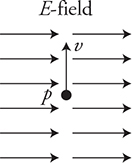
(B) 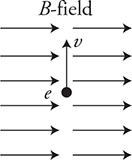
(C) 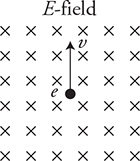
(D) 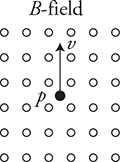
STOP: End of AP Physics 2 Practice Exam, Section 1 (Multiple-Choice)
AP Physics 2: Practice Exam 1
Section 2 (Free Response)
Directions: The free-response section consists of four questions to be answered in 90 minutes. Questions 1 and 4 are longer free-response questions that require about 25 minutes each to answer and are worth 12 points each. Questions 2 and 3 are shorter free-response questions that should take about 20 minutes each to answer and are worth 10 points each. Show all your work to earn partial credit. On an actual exam, you will answer the questions in the space provided. For this practice exam, write your answers on a separate sheet of paper.
1. (12 points—suggested time 25 minutes)
An air bubble is formed at the bottom of a swimming pool and then released. The air bubble ascends toward the surface of the pool.
(A) In a clear, coherent, paragraph-length response, describe any changes in the bubble size and describe the motion of the bubble as it ascends to the surface. Explain the factors that affect the size of the bubble and the bubble’s motion. Include a description of any forces acting on the bubble from the time it is at the bottom of the pool until the bubble is just below the surface of the pool.
(B) On the figure, draw a vector for each force acting on the bubble. Make sure all vectors are drawn in correct proportion to each other.

(C) The bubble does not collapse under the pressure of the water. Explain how the behavior of the gas atoms keeps the bubble from collapsing.
(D) The bubble begins at a depth of D below the surface of the water where the bubble has an initial volume of VD. The atmospheric pressure at the surface of the pool is PS. The density of the water in the pool is ρ. Assume that the air temperature in the bubble remains constant as it rises to the surface. Derive an expression for the volume (VS) of the bubble when it reaches the surface of the pool.
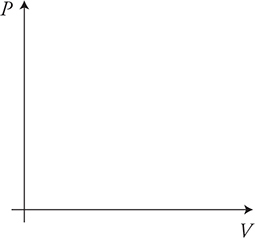
(E) In part (D) it was assumed that the temperature of the bubble remains constant. Now assume that the air temperature in the bubble can change but that the bubble rises so quickly to the surface that there is negligible thermal energy transfer between the bubble and the swimming pool water. Base your answers on this assumption.
i. Sketch the process on the PV diagram. Indicate on the axis the initial and final pressures and volumes.
ii. How does the value PSVS compare to the value PDVD?
__Greater than PDVD __Equal to PDVD __Less than PDVD
Justify your answer.
2. (10 points—suggested time 20 minutes)
Some students are investigating how the geometry of the cylindrical shaft of graphite in a wooden pencil influences the resistance of the graphite. The students use a 9 V battery as an emf source. In the first part of the investigation, the students choose to investigate the influence of length on the resistance of the graphite conductive pathway.
(A) i. Besides the graphite and battery, what additional equipment would you need to gather the data needed to determine the influence of length on the resistance of the graphite conductive pathway?
ii. Using standard symbols for circuit elements, draw a schematic diagram of the circuit the students could use to determine the influence of length on the resistance of the conductive pathway. Include the appropriate locations and electrical connection of all equipment including any measuring devices. Clearly label your diagram.
iii. Describe the procedure you would use with your circuit to gather enough data to determine the influence of length on the resistance of the conductive pathway. Make sure your procedure is detailed enough that another student could perform the experiment.
iv. The 9 V battery used in the experiment has a sizable internal resistance. Would you need to change your procedure in part iii? Justify your answer.
Next the students investigate how the geometry of Play-Doh influences the resistance of cylindrical lengths of Play-Doh used as a conductive pathway. The investigation results in the data in the table.
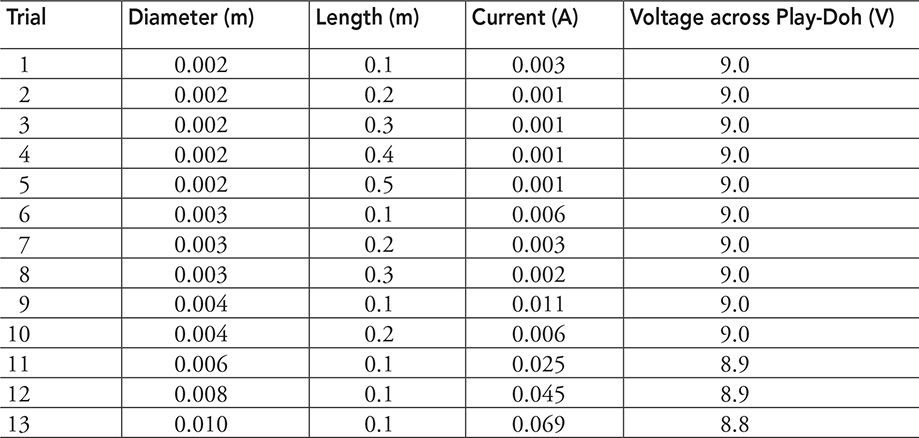
(B) i. Which subset of data would be most useful in creating a graph to determine the relationship between the resistance and diameter of the Play-Doh? If the data chosen are incomplete, fill in the needed data in the extra columns provided in the table.
ii. Plot the subset of data you chose on the axis, being sure to label the axis. Draw a line or curve that best represents the relationship between the variables.
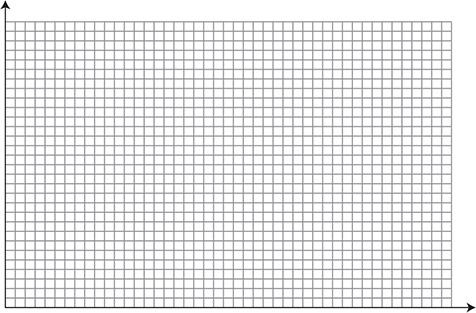
iii. What can you conclude from your line or curve about the relationship between the resistance and diameter of the conductive pathway?
iv. How can you prove that the relationship you suspect between resistance and diameter is correct?
v. The students who produced this data set said, “It took a long time to measure these data, and the Play-Doh was noticeably drier by the end of the lab.” Will this influence the validity of the relationship you concluded in part iii?
Justify your answer.
![]()
3. (10 points—suggested time 20 minutes)
A gas with a ground state of —8.0 eV is illuminated by a broad spectrum of ultraviolet light and is found to absorb the 248 nm wavelength of light. When the ultraviolet light is turned off, the gas sample emits three different wavelengths of light: 248 nm, 400 nm, and 650 nm.
(A) On the axis provided, construct and label an energy level diagram that displays the process of both the absorption and emissions by the gas. Show your supporting calculations below.
(B) The light emitted by the gas is directed toward a sample of tin. It is found that the 248-nm emission from the gas causes electrons to be ejected from the tin, but that the 400-nm emission does not. Will the 650-nm emission eject electrons from the tin? If so, explain how it could be accomplished. If not, explain why it is not possible.
(C) The light from the gas is now directed at a sample of potassium that subsequently ejects electrons with a maximum energy of 2.71 eV.
i. Calculate the de Broglie wavelength of the maximum energy electrons.
ii. These electrons are directed at two small openings spaced 2 nm apart. Will this result in the formation of an interference pattern? Justify your answer using appropriate physics principles.
4. (12 points—suggested time 25 minutes)
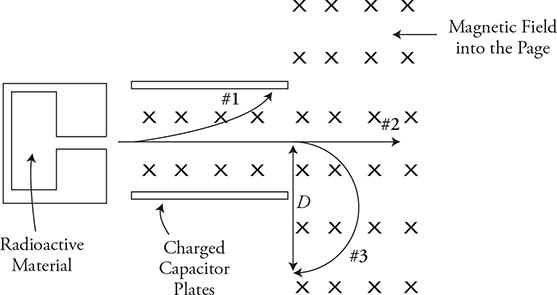
A sample of radioactive sources is enclosed within a lead-shielded container with a narrow exit aperture that ensures that any ejected particles will exit the container directly to the right. The ejected particles pass between charged parallel conductive plates and a region of magnetic field that is directed into the page. Three particles exit the container and follow paths as shown in the figure. Students observing the particles make these statements:
Student A: Both particles 2 and 3 pass through the capacitor region undeflected so there is no net force on them. They both must be neutral particles.
Student B: The path of particle 3 implies it has a negative charge. Therefore, the bottom plate of the capacitor must be negatively charged.
Student C: Particle 1 is positive because it curves upward.
(A) List all parts of the students’ statements that are correct. Explain your reasoning for each.
(B) List all parts of the students’ statements that are incorrect. Explain your reasoning for each.
(C) On the figure, sketch the electric field vectors between the capacitor plates that are consistent with the motion of the particles.
(D) Particle 3 is detected at distance D from its exit point from the capacitor plates. Using this information, derive an expression for the charge to mass ratio (q/m) of particle 3 in terms of D, E (the electric field between the capacitor plates), and B (the magnetic field).
(E) Using the equation derived in (D), a charge to mass ratio (q/m) of 1.76 × 1011 C/kg was calculated. Explain how this number could be used to determine the set of possible masses of particle 3.
(F) One of the radioactive sources enclosed in the shielded container is fermium-257, which has 100 protons and a half-life of 100.5 days. Fermium transmutes into Californium (Cf) by emitting an alpha particle with a velocity of 2.0 × 107 m/s.
(i) Write the complete nuclear equation of this decay reaction.
(ii) Write, but do not solve, a symbolic expression that could be used to calculate the mass released to energy in one single fermium—257 decay.
(iii) Assuming the fermium—257 is isolated and stationary, calculate the velocity of the Californium nucleus after the alpha particle is ejected.
STOP: End of AP Physics 2 Practice Exam, Section 2 (Free Response)
Solutions: Section 1 (Multiple Choice)
Questions 1—45: Single-Choice Items
1. B— The mass of argon is greater. Thus, at the same temperature, argon has the same kinetic energy but a slower average speed. This shifts the curve to the left. Since the number of moles is the same, the peak of the argon graph must be higher to accommodate the same number of atoms.
2. D—The exit velocity is proportional to the water pressure at the hole, which is proportional to the depth of the water: P = P0 + ρgh.
3. D—The point source model shows us that the larger the wavelength, the greater the bending of the wave around the corner. We can also see this in the equation for diffraction:  . As the wavelength gets smaller, the diffraction bending angle also gets smaller. Visible light has a very small wavelength and only bends a tiny amount around corners.
. As the wavelength gets smaller, the diffraction bending angle also gets smaller. Visible light has a very small wavelength and only bends a tiny amount around corners.
4. C—Only electrons can move in the metal spheres. Protons (positive charges) are stuck in the nuclei of atoms and cannot move. In the presence of the positively charged rod, the three-sphere system will polarize with excess electrons moving toward the positively charged rod. Answer choice A shows no charge polarization. Choice B shows each individual sphere polarized, which cannot happen since the conductors are in contact and act as one system. Choice D shows protons moving, which also cannot happen.
5. D—Electric field lines are perpendicular to the isolines and point from higher potential to lower potential. The average electric field strength is  . Therefore, the electric field at point A will be stronger than at point B.
. Therefore, the electric field at point A will be stronger than at point B.
6. C—The force from sphere 1 on sphere 3 is ½ F to the left. The force from sphere 2 on sphere 3 is 2 F to the left. The sum is (5/2) F.
7. B—The current is the same; therefore, the higher the resistance, the greater the electric potential. Use the resistance equation to find the relative magnitude of the three resistors:  .
.
8. D—Originally only bulb A is lit, and it experiences all the emf of the battery. When the switch is opened, the emf of the battery is split evenly between the bulbs.  ; therefore, the power dissipation by bulb A is one-quarter of the original value.
; therefore, the power dissipation by bulb A is one-quarter of the original value.
9. C—Special relativity tells us that when two observers are moving relative to each other, they will not necessarily agree on length and time. This becomes evident when we get up near the speed of light. We start to easily notice the effect around 0.1 c and faster. The only constant that all observers will agree on is the speed of light.
10. C—The original velocity is toward the top of the page. The force on the proton is out of the page. Therefore, by the right-hand rule, the magnetic field is directed to the left.
11. B—Newton’s third law.
12. B—The three resistors in the bottom right corner are in parallel. Since they all have the same resistance and the same electric potential across them, they must also have the same current. Ammeter #3 is the sum of the currents in the top two resistors and will be twice as large as ammeter #4.
13. B—The three resistors in parallel add up to a resistance of ⅓ R. Adding these in series with the resistor in the main line, we get 4/3 R.
14. D—The data in the table suggest that gas pressure and volume are inversely related:  . This is also seen in the Ideal Gas model:
. This is also seen in the Ideal Gas model:  . Therefore, plotting P on the vertical axis and 1/V on the horizontal axis will produce a straight line from which the number of moles could be calculated knowing that the slope will equal nRT.
. Therefore, plotting P on the vertical axis and 1/V on the horizontal axis will produce a straight line from which the number of moles could be calculated knowing that the slope will equal nRT.
15. C—The ranking will be based on the P × V value: TC > TB = TD > TA
16. B—Both paths start and end at the same point. Therefore, the initial and final temperatures are the same, as are the initial and final thermal energies. Process 1 has a higher average pressure for the same volume change. Another way to think about it is to compare the area under the curves. Graph 1 has more area underneath and, therefore, a larger magnitude of work.
17. B—The weight of the blocks is balanced by the buoyancy force. Since the blocks are half submerged, their densities are half that of water:

18. D—Using the conservation of mass/continuity equation, we see that the water must be slower at the hydrant than exiting the nozzle:
![]()
The area of the hose is proportional to the diameter squared:

This gives us a velocity in the hose of 1.125 m/s.
Using conservation of energy/Bernoulli’s equation and assuming the exit pressure is atmospheric,
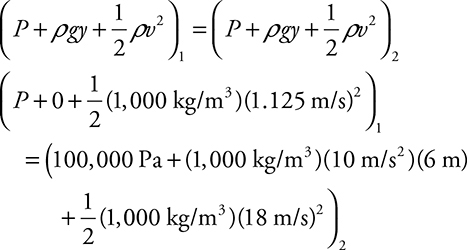
19. A—Gravity is proportional to the product of the two masses, and the electric force is proportional to the product of the two charges. Since the mass of an electron is on the order of 10—31 kg, and the charge is on the order of 10—19 C, the electric force will be much larger than the gravitational force. In addition, the universal gravitational constant is much smaller than the Coulomb’s law constant. This makes the gravitational force between the electrons negligible compared to the electric force.
20. B—The charge of Psevdísium is smaller than the electron charge, which calls this particle’s existence into doubt. Within the level of uncertainly listed, the charge of Alithísium is ten times the charge of the electron. We would expect the charge to be a whole integer multiple of the electron charge. The mass of Alithísium is listed as an energy equivalent. This is perfectly acceptable: E = mc2.
21. C—Electric field vectors are always perpendicular to the equipotential lines. The pattern of the electric field vectors indicates that both charges are the same sign. Additionally, there is no zero potential line separating the two charges, indicating that they have the same sign. The equipotential lines indicate that the charge on the right has a larger magnitude.
22. D—It is not possible to separate a north pole from a south pole. All magnets are dipoles. When you break a magnet in half, you get two weaker magnets. If they stayed the same magnitude as the original, we would be violating conservation of energy.
23. C—By the right-hand rule, the magnetic force on the proton is to the left. Originally, the electric and magnetic forces were equal. Since the velocity has increased, the magnetic force is now larger than the electric force that is to the right.
24. D—The diaphragm vibrates back and forth along the axis of the magnet, changing the magnetic field strength through the coil area.
25. C—The law of reflection is not influenced by the water. Snell’s law of refraction depends on the indices of refraction of the two materials. The speed of light changes less going from water to lens then going from air to lens. This means there will be less refraction in water, making the focal length larger.
26. B—Electromagnetic waves are transverse, with both the E- and B-fields oscillating perpendicular to the direction of motion and each other.
27. D—The lens equation can be rearranged to produce a straight line:

Thus, if we plot 1/so on the x-axis and 1/si on the y-axis, we should get a graph with a slope of —1 and an intercept of 1/f. The image distance is x2 — x1, and the object distance is x0 — x1.
28. B—When the angle of the prism decreases, the right side of the prism becomes more vertical, and the angle of incidence with the normal becomes smaller. This creates less refraction and the distance (x) increases. Consider the extreme case when θ becomes zero. Then the angle of incidence is zero, and there is no refraction at all. The beam will pass straight through the “prism” because it has become flat like a window, and the distance (x) becomes infinite.
29. C—The particle is most likely to be found at the highest positive/negative amplitude location of Ψ as a function of x. The particle will not be found at locations —15 nm and 0.0 nm.
30. C
![]()
Solve for A and Z. A = 32 and Z = 16. Knowing that alpha particles have two protons and four nucleons, we can divide 32 by 4 or divide 16 by 2 to find out that we need 8 alpha particles to balance the equation.
31. B—The block has a mass of 190 g, but the reading on the spring scale is only 120 g when it is submerged in the water. This means that the buoyancy force equals 70 g. Newton’s third law reminds us that this force is upward on the block and downward on the water, which increases the balance reading. When the metal block is lifted out of the water, the buoyancy force between the block and the water disappears. This makes the spring scale reading go up by 70 g and the balance reading go down by 70 g. Note that mass of the block is 190 g. Therefore, the spring scale reading must be 190 g when the block is lifted out of the water!
32. C—In process 3, the work done is zero: W = 0. The temperature and the internal kinetic energy of the gas are increasing. Therefore, thermal energy must be entering the gas: ΔU = Q.
33. C

The helium is moving at half the speed and has four times the mass of hydrogen. This means they both have the same average kinetic energies and the same temperatures:
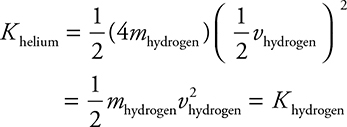
Objects with the same temperature are in thermal equilibrium and do not transfer any net thermal energy between them.
34. C—Adding heat to the gas from the resistor will increase the kinetic energy and temperature of the gas. The kinetic energy of the gas is proportional to the velocity squared:

Thus, the average velocity of the gas is proportional to the square root of the energy added to the gas (E).

35. D—Without knowing the exact locations, it is impossible to know the exact electric field strength. Since electric field is proportional to ![]() , the electric field strength varies in strength in the three regions.
, the electric field strength varies in strength in the three regions.
36. C—For the electron to receive a force to the left, the electric field must be pointing to the right. The electric field from the charge at vertex B must be smaller in magnitude than the field produced by the charge at vertex A. To accomplish this, the charge at point B must be negative and smaller than |+q|.
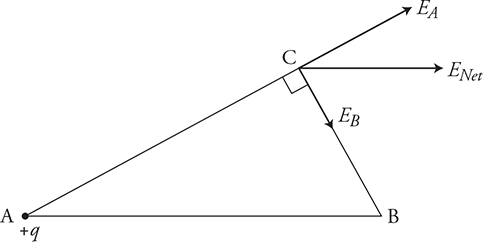
37. A—Near the edges of the capacitor, the electric field is still pointing in the same direction but is weaker than between the two plates. Thus the electric force on e1 is smaller in magnitude than on the other charges. The electric field forces both electrons to the right and the protons to the left.
38. B—The reading in ammeter 1 never changes because the potential difference and resistance in that line does not change. The capacitor behaves like a wire when uncharged and like an open switch when fully charged. This behavior changes the current through ammeter 2 as time passes.
39. D— . The slope of the right graph will equal the reciprocal of the resistance.
. The slope of the right graph will equal the reciprocal of the resistance.
40. B—Use the right-hand rule for magnetic fields around current-carrying wires.
41. A—The image is upright and smaller. This means the image is virtual, the image distance is negative, and the mirror must be diverging/convex.
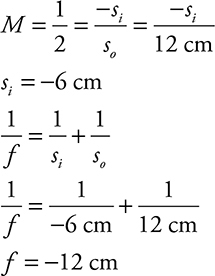
42. C—The amplitude is about 3 mV/m, and the time period is 0.5 ns. Using the wave equation, we get

43. A—The frequency remains the same. The wavelength of light is directly proportional to the speed of light in the substance. Light travels faster in water than through glass; therefore, λw > λg.
44. D—The electrostatic repulsion of the protons is much stronger than the gravitational attraction of the nucleons. Thus, we need a stronger force to hold the nucleus together. Scientists call this the nuclear strong force.
45. B—Ohmic materials will have a constant ratio of current to potential difference. This shows up on a graph as a straight line.
Questions 46—50: Multiple-Correct Items
(You must indicate both correct answers; no partial credit is awarded.)
46. C and D—Four capacitors connected in series result in a capacitance one-quarter the size of the individual capacitors. Our equation for capacitance is:  . To get a single capacitor with one-quarter the capacitance, we need to get a factor of four in the denominator.
. To get a single capacitor with one-quarter the capacitance, we need to get a factor of four in the denominator.
47. B and D—The sum of the forces must equal zero. Therefore, the buoyancy force upward must equal gravity downward minus the tension upward. Buoyancy force is ρVg, and the volume of the block is a2(h1 — h2).
48. A and D—The Ideal Gas model (PV = nRT) shows us that gas pressure is directly related to gas temperature (P ∝ T). This is seen in the straight line data represented in the graph. The slope of this graph will be equal to ![]() . Since the volume of the gas is given, the number of moles—and thus, the number of atoms—in the gas can be calculated using the slope. The x-intercept represents the temperature of the gas when the volume reaches zero. This point is absolute zero. The area of a PV diagram would represent work. We cannot calculate the force from the pressure because we do not know the surface area of the container. We are only given the volume.
. Since the volume of the gas is given, the number of moles—and thus, the number of atoms—in the gas can be calculated using the slope. The x-intercept represents the temperature of the gas when the volume reaches zero. This point is absolute zero. The area of a PV diagram would represent work. We cannot calculate the force from the pressure because we do not know the surface area of the container. We are only given the volume.
49. A and C—Sphere A is negative, and sphere B is positive. The rod polarizes the system that consists of the two spheres, pulling excess electrons to the left and leaving the right side with an excess positive charge of equal magnitude.
50. A and D—Be careful! Make sure you are paying attention to which of these is a magnetic field and which is an electric field. Electric forces are along the axis of the field. E-fields push positive charges in the direction of the field. Negative charges are pushed in the opposite direction of the E-field. Magnetic forces abide by the right-hand rule. Only moving charges experience forces from B-fields.
Solutions: Section 2 (Free Response)
Your answers will not be word-for-word identical to what is written in this key. Award points for your answer as long as it contains the correct physics explanation and as long as it does not contain incorrect physics or contradict the correct answer.
Question 1
Part (A) 5 points total for a well-constructed and easy to read explanation that contains the following:
1 point—The amount of air inside the bubble remains the same during ascent.
1 point—The external pressure from the water on the bubble decreases as the bubble rises.
1 point—The bubble increases in volume as it moves upward.
1 point—As the bubble volume increases, the buoyancy force increases, but the gravity force on the bubble remains constant.
1 point—The bubble accelerates upward at an increasing rate as it ascends.
Part (B)
1 point—For buoyancy force upward and gravity force downward. Buoyancy must be drawn larger than gravity. If extra vectors are drawn, this point is not awarded.
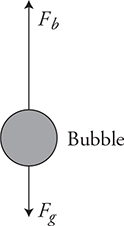
Part (C)
1 point—The atoms inside the gas collide with and bounce off the water molecules. This causes a change in momentum of the gas atoms. This generates an equal and opposite force between the water and gas that keeps the bubble from collapsing.
Part (D)
1 point—For the correct relationship between the pressure at the surface of the water and at a depth D: PD = PS + ρgD.
1 point—For the correct application of the ideal gas law and the correct final expression:
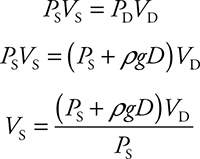
Part (E)
(i)
1 point—The sketch should have the shape of an adiabatic process, with an upward concave curve similar to that for an inverse relationship. The initial and ending points should be marked as seen in the figure. Pressure decreases and volume increases.
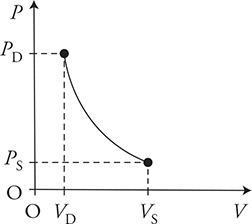
(ii)
Note that no points are awarded for checking the blank “Less than PDVD.” Points are awarded for the justification as follows:
1 point—The process is an adiabatic expansion. There is no heat transfer between the water and the bubble. Therefore: Q = 0, and ΔU = W.
1 point—Since the work is negative as the bubble expands, the internal energy of the bubble must also decrease. Therefore, the temperature and the PV value must also decrease.
Question 2
Part (A)
(i)
1 point—Minimum equipment: wires, voltmeter, and ammeter. Note that the equipment that is listed must be used in the lab procedure.
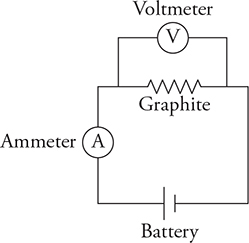
(ii)
1 point—There are several ways to draw this. The key is that the ammeter is in series with the battery and the graphite. The voltmeter must be in parallel with the graphite to measure the correct potential difference. The graphite should be drawn as a resistor and the entire schematic needs to be labeled.
(iii)
1 point—Procedure:
1. Connect the graphite, ammeter, and battery in series.
2. Connect the voltmeter in parallel with the graphite.
3. Measure the current and voltage.
4. Repeat for several lengths of graphite.
(iv)
1 point—Since the current and voltage are measured for the graphite specifically, the internal resistance of the emf source is irrelevant.
Part (B)
(i)
1 point—Trials: 1, 6, 9, 11, 12, and 13 are the best because they give the widest quantity and spread of data for a constant length segment of Play-Doh with differing diameters.
1 point—The resistance is missing and needs to be calculated. (See the table.)
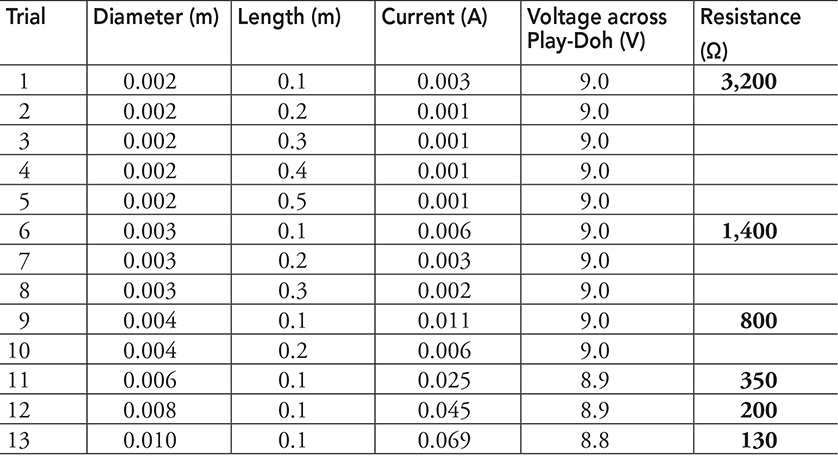
(ii)
1 point—Data point must be correctly plotted. The axes must be correctly labeled. The graph should be a curve.
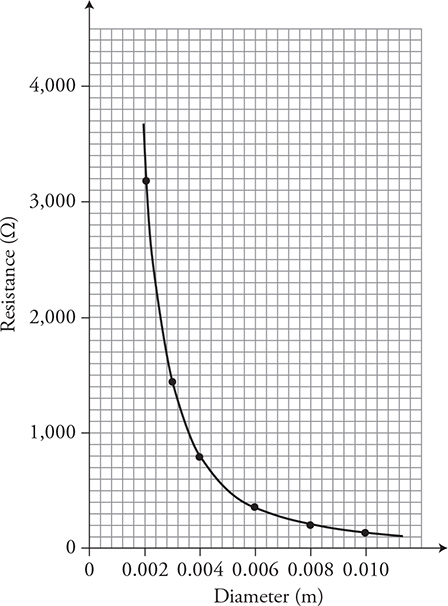
(iii)
1 point—For a statement that the resistance appears to be inversely related to the diameter (or the diameter squared).
(iv)
1 point—To determine if the relationship between resistance and diameter is inverse (or inverse squared), we need to graph R — vs — 1/d (or R — vs — 1/d2) and see if this graph produces a straight line.
(v)
1 point—The changing water content of Play-Doh could change the resistivity of the material and the resistance-diameter relationship, which damages the validity of the lab. It is a variable that is not held constant and calls the validity of the experiment into question.
Question 3
Part (A)
There are two ways to construct this energy level diagram. Both are shown below.
1 point—For converting the wavelengths of light in energy in electron volts.

1 point—For drawing energy levels at both —8 eV and —3 eV. (See figure below.)
1 point—For drawing an additional energy level at either —4.9 eV or —6.1 eV. (See figure below.)
1 point—For drawing an arrow upward from the —8 eV energy level to the —3 eV energy level to indicate the absorption of the 248 nm photon. (See figure below.)
1 point—For drawing three downward arrows as shown in the diagram below and indicating the emission of the 248 nm, 400 nm, and 650 nm photons.
Note: Only one of the diagrams below needs to be drawn by the student.
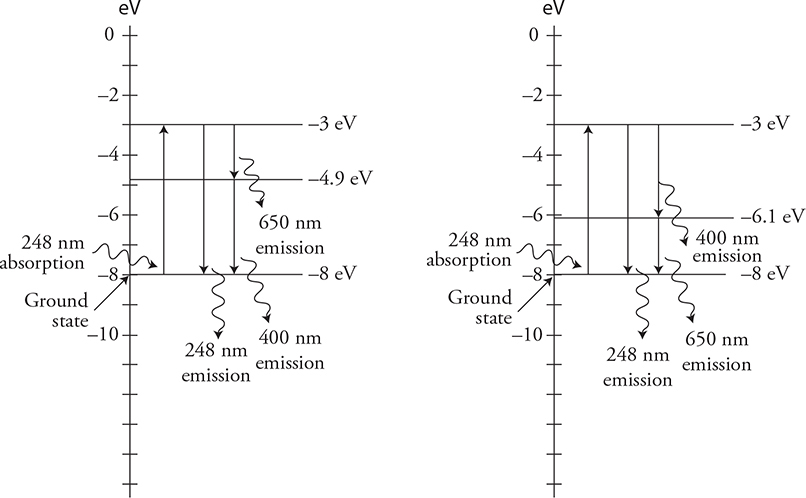
Part (B)
1 point—For indicating that the 400 nm photon is below the threshold energy (work function) needed to eject an electron.
1 point—For indicating that the 650 nm photon has even less energy than the 400 nm photon.
Part (C)
(i)
1 point—For converting the electron energy from eV into joules of kinetic energy and then into an electron velocity.
Electron kinetic energy = (2.71 eV)(1.6 × 10—19 J/eV) = 4.34 × 10—19 J
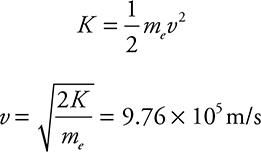
1 point—For calculating the de Broglie wavelength.

(ii)
1 point—For indicating that an interference pattern will form with appropriate justification. Here is an example explanation:
The electrons will form an interference pattern, as the waves are on the same order of magnitude and smaller than the opening spacing. The equation  shows us that the ratio
shows us that the ratio ![]() needs to be less than 1 for an interference pattern to form. Any larger ratio will cause the angle θ to be larger than 90 degrees, and no pattern will form. This means the wavelength must be smaller than the spacing, but not too small or the angle will be so small that the pattern will be too small to see.
needs to be less than 1 for an interference pattern to form. Any larger ratio will cause the angle θ to be larger than 90 degrees, and no pattern will form. This means the wavelength must be smaller than the spacing, but not too small or the angle will be so small that the pattern will be too small to see.
Question 4
Part (A)
1 point—Student A is correct that particles 2 and 3 have no net force acting on them while between the charged plates. This is evident in the fact that they travel in a straight line through the charged plate.
AND
Student A is correct in stating that particle 2 is neutral as it travels in a straight line through the magnetic field on the right. Knowing that a charged particle will experience a force while passing through a magnetic field, particle 2 must be uncharged.
1 point—Student B is correct in stating that particle 3 must have a charge, since a moving charged particle will experience a force when passing through a magnetic field. Student B is also correct in stating that the path implies a negative charge. According to the right-hand rule for a charged particle in a magnetic field, the direction of force on a moving charged particle will be perpendicular to both the magnetic field and the direction of positive charge motion. Using this right-hand rule, we find a circular path directed upward for a positive charge, thus the downward curve of particle 3 suggests a negative charge.
AND
Student B is correct in stating that the bottom plate must be negatively charged. Since particle 3 is negative as previously stated, the negative charge will experience a downward force from the magnetic field. In order to maintain a straight line and thus no acceleration, particle 3 must experience an upward force to balance the downward force. This can be achieved only if the bottom plate repels the negative charge upward, indicating that the bottom plate is negatively charged.
Part (B)
1 point—Student A is incorrect in stating that particle 3 is neutral as evidenced by the fact that it experiences a force exerted by the magnetic field and arcs downward as soon as it leaves the electric field between the charged plates.
1 point—Student C is incorrect in stating that particle 1 is positively charged. Although the direction of the magnetic force on a positive charge would be upward, the bottom plate is negative and the top plate is positive. Thus, the electric force on particle 1 is downward. It is not possible to tell from the given information what the charge of particle 1 is. We can only say for sure that particle 1 has a net charge.
Part (C)
1 point—For indicating that the electric field is pointing directly downward between the plates and uniform in strength.
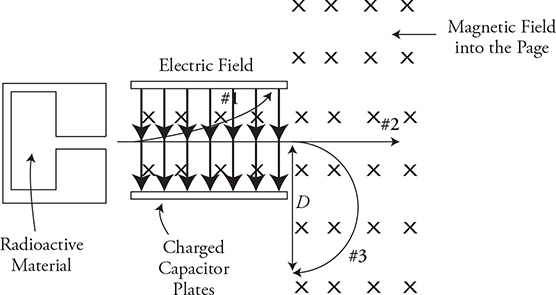
Part (D)
1 point—For finding the velocity of particle 3 using the magnetic and electric forces between the plates:

1 point—For setting the magnetic force equal to the centripetal force in the magnetic field:
![]()
1 point—For the correct expression for charge to mass ratio:
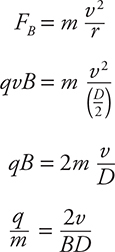
Substituting in the equation for velocity from above:
![]()
Part (E)
1 point—For clearly explaining that only multiples of the electron charge can be used to find the possible masses of particle 3.
Example: The mass can be found by dividing the charge by the charge to mass ratio (q/m). However, we know that particles come only in multiples of the electron charge. So, dividing the multiple of the electron charge by the charge to mass ratio will give us a set of possible masses for particle 3.
Part (F)
1 point—For the correct nuclear equation showing Californium as the end product with the correct atomic number and atomic mass number:
![]()
1 point—For a correct expression of masses and utilizing E = mc2:

1 point—For a correct velocity of the Californium nucleus:
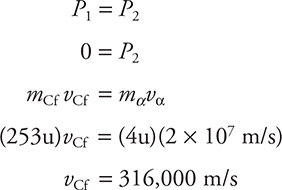
How to Score Practice Exam 1
The practice exam cut points are based on historical exam data and will give you a ballpark idea of where you stand. The bottom line is this: If you can achieve a 3, 4, or 5 on the practice exam, you are doing great and will be well prepared for the real exam in May. This is the curve I use with my own students, and it is has been a good predictor of their actual exam scores.

Calculating Your Final Score
Final Score = (1.136 × Free-Response Total) + (Multiple-Choice Score)
Final Score: _____________ (100 points maximum)
Round your final score to the nearest point.
Raw Score to AP Grade Conversion Chart
